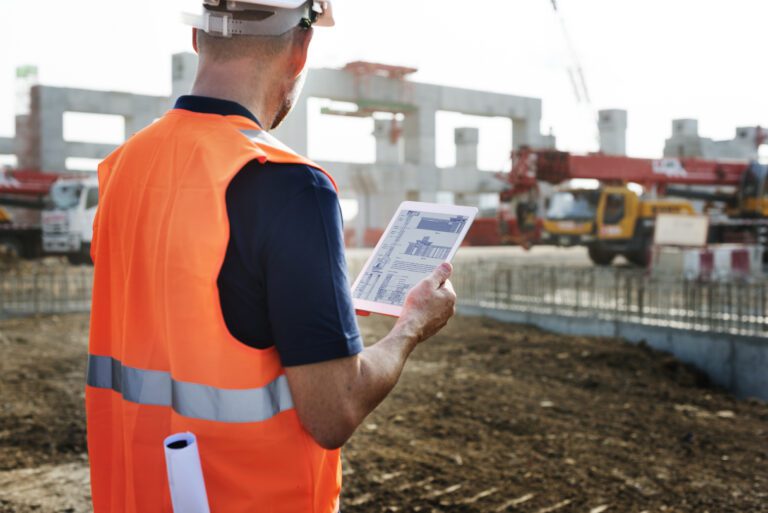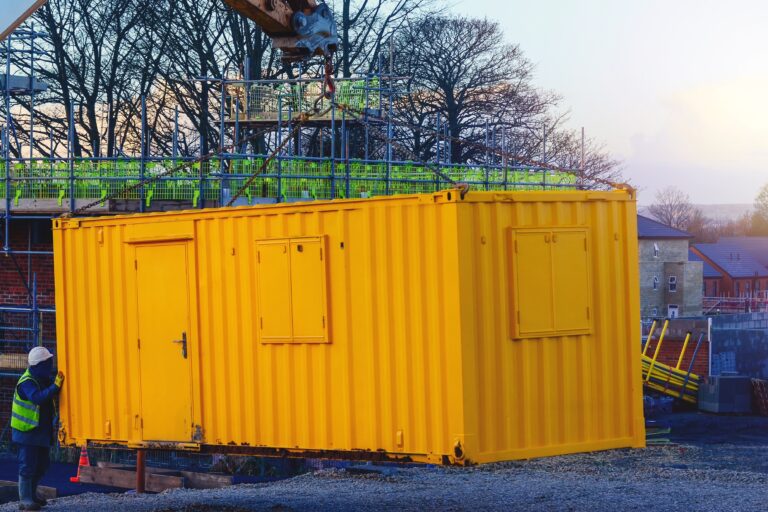19th February, 2024
The rise of off-site modular construction
The benefits of modular construction and how the building industry must embrace technology to keep up with the pace of prefab build progress.
Modular construction has existed for centuries. Yet it is only now, with the growth of technology and changing social-economic pressures, that construction companies worldwide are turning their attention back to the many benefits of off-site manufacturing. In fact, the modular construction market is valued at approx. €17 bn. This new method is proving popular for several factors, including cost-efficiency, sustainability, and quality control.
So, what is modular construction?
In contrast to traditional build methods, modular construction is the process of building 2D and 3D prefabricated elements off-site before shipping them to the building site for final assembly in situ. As much as 80% of the building takes place off-site, which is a massive shift in approach from conventional construction. This inevitably impacts every aspect of the build, from design and planning to logistics and manpower, putting enormous pressure on procurement managers and company owners to quickly adapt company processes in order to keep up.
But why do we think now’s the time that modular construction is going to overtake traditional construction for good, and how can the industry prepare for the change?
Love it or loathe it? A short history of modular construction
The ‘popularity’ of modular construction has peaked several times in recent history. Most notably, in post-war Britain, we saw a spike in the use of prefabricated or modular construction methods, with a nationwide push to rebuild quickly.
Traditional materials and skilled labour were in short supply, so prefab buildings became a familiar sight up and down the country. With tight budgets, the focus was on function over form, so many of us will have grown up with a less-than-favourable view of modular construction. As soon as the economy returned to normal, the modular prefab was dropped in favour of traditional, and perceived, better-quality forms of construction.
Once again, however, with the rise of the European refugee crisis, governments and construction companies are turning to modular construction to offer quick, cost-effective solutions to the huge demand for shelter, housing, hospitals and schools. As the history of modular construction has demonstrated, this radically different build style has its uses, especially in an emergency. However, industry-wide doubts about build quality, safety and longevity mean that modular construction might struggle to secure a long-term future. Until now, that is.
So, what’s changed and why is modular construction here to stay?
From better materials and new technologies to waste reduction, these are not the modular construction manufacturers of the past.
Technology and progress
Technology is advancing, and fast. It’s now possible to manufacture large parts of any building in modular form off-site. In the past, modular construction was quick and cheap, leading to the common view that modular was a cost-effective yet low-quality, short-term building fix.
With precision design, new lightweight materials, and car-manufacturing style processes taking place under factory conditions, modular construction is a truly modern alternative – offering advanced quality control and safety checks carried out off-site.
For example, the BROAD group in China claims their modular buildings are “ten times lighter and stronger than conventional structures, and they are resistant to earthquakes and typhoons.” From luxury builds to 200-storey skyscrapers for residential or commercial use, modular construction processes are now widely seen as a high-quality alternative to traditional methods.
Proven cost-reduction and efficiency
Prefabricated modular construction is built for efficiency. For example, lowering ceilings for tradespeople so they don’t waste time going up and down podiums, all while reducing health and safety risks. There is a massive opportunity for construction companies and the industry to reduce overall project times.
For the UK, where demand for real estate is high, and the availability of skilled labour is low, the modular construction model offers a quick and cost-effective alternative to traditional builds. According to a recent report by McKinsey & Company, modular construction results in a 20% reduction in building project costs. The report shows that prefabricated modular construction can cut build times by as much as half. This is a huge potential win for procurement managers whose job is keeping every project on time and budget.
However, the construction industry is still the least digitised sector in Europe, with inefficiencies costing $1.6 trillion each year – this will quickly need to be addressed if they are to benefit from the potential savings of modular construction solutions.
The drive to net zero
Today, sustainability is at the heart of every leading company’s business strategy. In construction, it’s even more critical to demonstrate that a commitment to sustainability goes beyond words. Currently, building construction is responsible for approximately 40% of all primary energy use, 26% of materials and resources used, and 35% of waste generation.
With advances in sustainable materials, a reduction in on-site build times and a decrease in the long-term use of heavy construction machinery, modular construction solutions offer real hope to lower the environmental impact of the building industry. Modular construction also provides the option to recycle and reuse in the most literal way by allowing a building to be picked up and moved to another site when needed.
However, real sustainability progress can only be achieved if the industry accepts that a change of approach across the supply chain system is needed.
The future looks modular
The McKinsey report also suggests that a dramatic shift in the mindset of construction-industry CEOs is finally causing a profound change and could see modular construction replace traditional methods once and for all.
Construction industry CEOs, previously resistant to adopting modular construction solutions, are now seeing the upsurge in challenger brands employing new technologies. Company leaders realise it’s time to embrace the future or fall behind. Attention now falls on procurement managers to adapt to an entirely new way of working.
The problems facing modular construction: an industry adverse to change
The construction industry has always been notoriously slow to adapt to change. In our recent study commissioned with Censuswide, a lack of digital tools and innovation is the biggest challenge faced by as much as 31% of senior procurement decision-makers in UK construction firms.
The report also observes that just under two-thirds of those who took part in the research still use manual methods, such as a spreadsheet or pen and paper, to manage their procurement and site inventories. With such slow adoption of even straightforward technology, it will be challenging for teams to adapt to a systemic shift in build practices.
So, what do procurement managers need to effect the change they need to see to modular construction? As with so many industries pioneering change, technology holds the key.
A centralised supply chain
The construction supply chain is already very complex and governed by outdated systems. The number of people involved, the time spent contacting suppliers, and the effort sourcing the right equipment for a job. When you throw several modular construction prefab centres into the mix, the procurement manager’s job gets a whole lot more complicated, inefficient and hard to manage.
This is why it’s more pressing now than ever that the industry embraces technology. Our research shows that a lack of digital tools contributes significantly to increased supply chain costs – almost 44% of total project spend. Tech will be the differentiator that gives construction companies a competitive advantage.
YardLink’s digital platform can help procurement teams solve many problems by centralising their supply chain into one platform. It enables customers to source and manage equipment, materials and services through a single dashboard, regardless of supplier. Saving time for procurement teams, reducing costs for construction sites, and helping businesses meet their sustainability mandates. It’s easy to see how this kind of tech could be applied to a significant effect on multiple modular construction projects.
Sourcing local
Any progress made by the sustainable advantages of modular construction will be lost if procurement managers don’t step outside of the one-trusted-supplier comfort zone. Unlike the industry average of 60 miles, 95% of the products and tools YardLink helps source are delivered within 15 miles of our customer projects. So, if a contractor has multiple prefab sites, a nationwide supplier network like ours can help reduce wasted miles travelled from distant supplier depots. You can even stipulate a distance when submitting a request for quote if your business needs to meet very stringent sustainability mandates. The modular construction supply chain can harm the environment and the project’s bottom line without embracing opportunities like these.
Adapting to short-term thinking
Due to the nature of modular construction systems, even preparing the groundwork can be cut short. Whereas traditional builds often demand long-term heavy machinery hire and major excavation work for deep foundations, modular construction sites only require shallow excavation. Being able to easily hire and off-hire equipment will become increasingly important.
Usually a manual and time-consuming job, off-hiring equipment requires contacting the right supplier, often through different methods of communication and without a digital paper trail. Inevitably items get missed, collections fail, and equipment stays on-hire longer than needed, incurring further costs.
A digital solution that centralises your entire supply chain can enable one-click off-hiring, improving efficiencies and tackling overspending. As modular construction methods take over, with such quick turn around on projects, speedy and efficient procurement will be vital.
Embracing the future of modular construction
From an industry notoriously hard to regulate to a new approach to construction that emulates the manufacturing industry. Modular construction might seem huge, but with so many benefits, from time and cost savings to lowering the industry’s carbon footprint, we expect to see a sector-wide change. As we’ve discovered over the years, change is easier to achieve with the help of digital solutions. It will be fascinating to see how the industry responds.
YOU MIGHT ALSO BE INTERESTED IN















